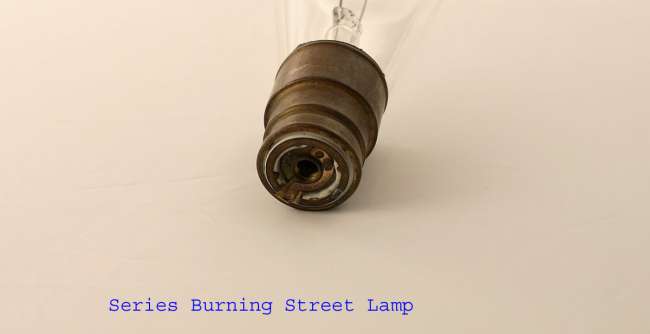c.1889 Street Series Bulb Lamp Base View
By Joe Maurath, Jr.; posted February 3, 2007
View Original: Click to zoom, then click to magnify (1200 x 617) 69KB

|
As you will see in my following submissions to this folder are comment how "strings" of street lights were designed to operate in series like a loop of ordinary Christmas Lights. If one burned out or failed, the rest remain lit! This Thomson-Houston street lighting lightbulb as shown here has a carbon filament and its base designed so that a slim piece of mica was inserted into it so that when the lamp failed the mica would quickly (and without injury to the fixture or other parts) burn through in an instant so that the remainder of the lights in the street lighting loop would remain lit. Circa 1900 screw-type street lighting lightbulbs came onto the scene and these had tungsten filaments and a provision within the bulb's plug-in socket whereby the "wafer" installed would innocently puncture upon lamp failure and was easily replaced upon lamp renewal. These plug-in sockets with such "cut-out" devices within the series' sockets blades have been the industry standard ever since. Street series lighting has been gradually becoming obsolete since the 1960's. Many street series circuits still remain in in midwestern and western US states. A few still utilize incandescent lamps with the remainder having mercury vapor and high pressure sodium luminaires. These more modern fixtures have the advantage of "one-wire" operation (one wire in...one wire out) with of course of fixture provision of loop continuity if any of the fixtures fail. |